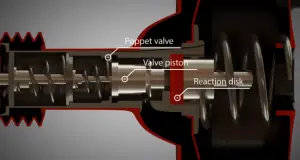How To Know If You Have A Vacuum Leak
How To Know If You Have A Vacuum Leak? What exactly is a vacuum leak? There is a leak somewhere between the engine and a mass air flow monitor. A bulk airflow sensor is often mounted at the air filter box in most vehicles. The mass air flow sensor in the fuel injection system monitors the air flow into the engine.
Depending on the mass air flow sensor data, the engine computer (PCM) determines how much fuel to inject.
A vacuum leak somewhere between the engine and the mass air flow sensor allows “unmetered” air into the system. As a result, the real air flow is more than what the mass air flow sensor indicates.
As a result, the PCM incorrectly estimates the amount of injected gasoline, causing the engine to run “lean.” The phrase “lean” refers to having too much air and not enough fuel. When the engine is idling, the effect of a vacuum leak is more obvious since the air flow is lower.
Vacuum Leak Symptoms
A vacuum leak can cause the Check Engine light to illuminate, as well as a rough idle, stalling, and a hissing sound from the engine room. The engine performs admirably at higher RPMs, but it surges, runs rough, and fails to maintain steady RPMs at idle.
When coming to a complete stop, the motor frequently stalls. One of the symptoms of a vacuum leak, as detected by a scan tool, is the Long Term Fuel Trim (LTFT) moving to the positive (lean) side (e.g., more than +15 percent) at idle but recovering to near zero at higher RPMs. This indicates that the engine is running low at idle.
Common Sources Of Vacuum Leaks
-
Intake Snorkel
A break or fracture in the rubber or plastic duct or boot (snorkel) that links the engine intake and the air filter box. It’s a frequent issue with older and high-mileage vehicles. The rubber boot must be changed, which is a simple fix.
Worm gear clamps at both ends are used to secure it in most automobiles. The component ranges in price from $25 to $65. A vacuum leak can also occur if an intake boot is not correctly fitted at an air filter box (as seen in this photo) or at a throttle body.
-
Intake Manifolds And Gaskets
An intake manifold is attach to the engine compartment or plenum by bolts. Plastic intake manifolds distort with age. Gaskets and O-rings used to seal gaps stiffen and shrink with time. This results in vacuum leakage. This issue is quite prevalent in many vehicles, including those manufactured by Ford, Toyota, Chrysler, and General Motors. Leaks are especially common in plastic intake manifolds.
Spilling gaskets and O-rings must be changed to remedy the situation. Although gaskets and O-rings are inexpensive, removing the intake manifold is time-consuming. The repair costs between $20 and $60 for parts (gasket kit), between $150 and 450 for labour. How To Know If You Have A Vacuum Leak?
-
Vacuum Tubes And Lines Made Of Plastic And Rubber
As they age, vacuum hoses become brittle and fracture or rip. Hoses and pipes connecting the PCV system to the intake manifold are particularly likely to fail.
Crankcase fumes include oil, which destroys the rubber or plastic, causing hoses and lines to expand and fracture. The L-shape rubber elbows that attach to the intake manifold, for example, were known to fail in several Ford/Mazda vehicles. A fracture vacuum hose or line must be replace. How To Know If You Have A Vacuum Leak?
The PCV system, or Positive Crankcase Ventilation, removes blow-by gases and oil vapours from the engine crankcase.
-
Brake Booster
Between the brake pedal and the brake master cylinder, a brake booster is placed. It is usually linked to the engine intake and is controlled by the engine vacuum. Booster brakes A vacuum diaphragm is located inside the brake booster.
When a brake booster fails, a vacuum leak occurs. A hissing noise emanating from the brake pedal region and a lack of braking support are symptoms of a leaky brake booster.
A leaking brake booster is a safety issue that must be address. Several manufacturers have issued brake booster recalls or warranty extensions. The recall R63 for select Dodge Dart vehicles was issued by FCA (Chrysler).
Conclusion
Vacuum leaks are not always straightforward to detect. A scan tool, specific spray, a vacuum gauge, and other testing equipment are used by mechanics. Mechanics frequently utilise a smoke machine to locate the cause of a vacuum leak in the intake manifold.
A smoke machine emits vapour that resembles smoke. This vapour is inject into the intake manifold, and a vacuum leak can be detect visually by vapour flowing out of the leak’s location.
If no machinery is accessible, check for typical faults in your Make, Model, and Year. If your automobile has a vacuum leak, it’s likely that someone else experienced the same situation in the same car. Try searching on YouTube or Google, for instance.




